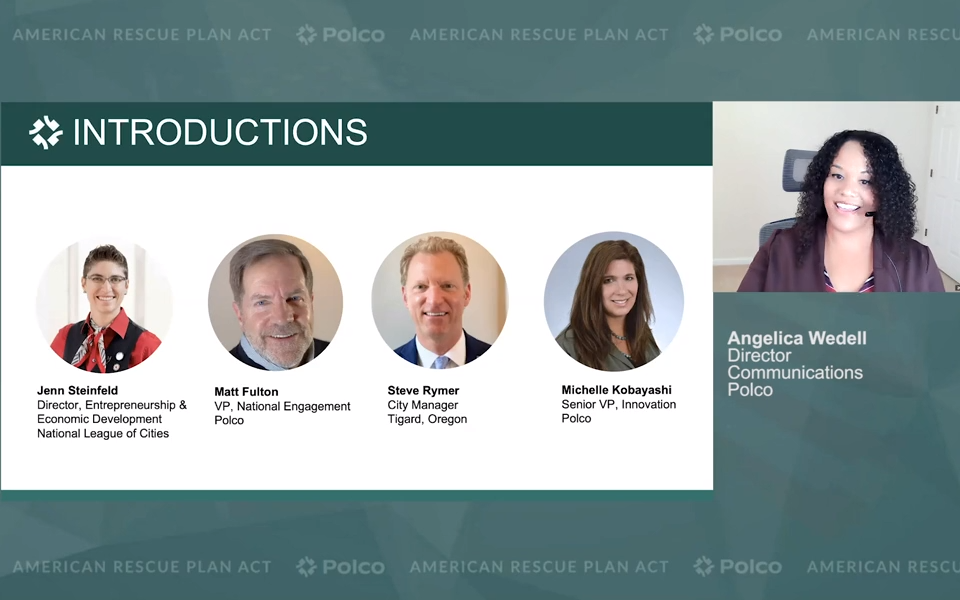Community Equity and Allocating ARPA Funds
By Polco on August 13, 2021

-Webinar facilitated by Matt Fulton-
As local governments work toward pandemic recovery, ARPA funds create new opportunities to help community groups impacted most.
In fact, Treasury guidelines ask leaders “to promote and streamline the provision of assistance to individuals and communities in greatest need, particularly communities that have been historically disadvantaged and have experienced disproportionate impacts of the COVID-19 crisis.”
So how can towns, cities, and county governments best spend ARPA funds equitably?
To find answers, we spoke with Amie Hendrix, ELGL board member and Assistant County Administrator for Tompkins County, NY. We also spoke with Dylan Feik, City Manager for Monrovia, CA. Last we spoke with Michelle Kobayashi, Senior Vice President of Innovation with Polco. These leaders are experts related to community engagement around equity and inclusion.
Polco’s Vice President of National Engagement Matt Fulton facilitated conversations with Hendrix, Feik, and Kobayashi about how to identify and assess disparities and prioritize and allocate funds for ARPA-related initiatives. They also share more information about Polco’s new ARPA Engagement Package.

Engaging Local Government Leaders
Engaging Local Government Leaders (ELGL) is one great resource for local governments as they navigate issues of equity and inclusion. ELGL is a professional association whose mission is to engage the brightest minds in local government.
“Equity and Inclusion is fundamental to ELGL. We want to make sure there is diverse membership on our board that people can reach out to. We also connect communities to each other and to resources,” said Hendrix.
ELGL hosts cohort programs for local government leaders to share what’s working and to learn from each other. ELGL also hosts podcasts and publishes blogs. Last, they publish a diversity dashboard that looks at the degree to which local government staff reflect the diversity of their community.
“The main focus of ELGL is connecting people and learning from everyone, because everyone has something that they can share...One of the things about local government is that we’re all in this together,” said Hendrix.
Tompkins County, New York
One way to consider how to best spend ARPA funds equitably is through learning from other communities.
Tompkins County, New York comprises the Ithaca, New York Metropolitan Area. Since the beginning of the pandemic, the County has improved their ability to connect with hard-to-reach members of their community.
One way Tompkins County leaders builds public trust is by going out in the community to provide much needed assistance. For example, they brought COVID testing to key areas. They also expanded their translation processes to help connect with more people.
“One of the big pieces was finding the natural leaders in our community. We identify them in non-traditional settings. They might not always be the faith leader at the front of a religious organization and they might not be the ones that usually work with the government. Then we bring them in and listen,” said Hendrix.
Tompkins County leaders have taken a number of different approaches to tapping into local community leaders and spending the time to listen. They have started a Community Ambassador Program which develops the leadership of non-traditional leaders and helps bring more diverse people to conversations. Leaders intentionally dedicate a lot of time and resources to just listening.
“Listening is the first step, but people have to know that you're actually ready to take action,” said Hendrix. “We over explain what an action may look like...We explain what is going to be implemented and why... We don't have the solutions that are going to be perfect for everyone. But we can take in the data and push forward with what we think is going to make the most sense for our community.”
One other step Tompkins County took was to build out their data team to be able to better understand who is most impacted by the pandemic and how we can best meet their needs.
Monrovia, California
Monrovia, California is another City that takes equity and inclusion seriously.
Recently the City Council formed an ad hoc committee on equity and inclusion. The Committee met with the staff of each of Monrovia’s seven departments to discuss what equity and inclusion means for them. Based on these conversations they developed 44 different priority goals to become a more diverse, equitable, and inclusive organization.
This document shapes the work each department does. For example, The Fire Department is meeting with the Women’s Fire Alliance to talk about how to train and develop female firefighters from an earlier stage. As another example, the City identified gaps in access to green space. So during a recent proposal for development, The City negotiated with a developer to donate a large piece of land as open space in a key area of Monrovia.
Monrovia’s focus on equity and inclusion is just one example of its culture of engagement.
“Engagement is not just a thing we do, but it’s just the way we do business,” said Feik.
Part of that culture of engagement includes engaging people the way they want to be engaged. Residents of Monrovia are very active on social media, so leaders push out a lot of information through there. Leaders use social media to share short surveys to seek resident opinion.
Monrovia’s leaders also believe that celebration is a huge part of engaging the community in equity and inclusion work. As part of a project called Neighborhood Treasures, local artists build public art pieces in the community to honor local folks who have made a difference.
Monrovia has yet to determine how they plan to spend their ARPA funds, but the City’s vision for equity and inclusion and their commitment to engagement will help guide their decisions.
“We plan to use this funding to drive generational change,” said Feik.
ARPA Engagement Package
Polco’s ARPA Engagement Package is designed to help local governments make more informed and equitable decisions about how to spend their ARPA funds.
“We created this ARPA Engagement Package in partnership with National League of Cities and The International City County Managers Association because we wanted local governments to have the tools to be able to spend their funds not just as BandAids but to support transformational or generational changes,” said Kobayashi.
Equity and inclusion is central to Polco’s ARPA Engagement Package.
“Disparities that already existed in communities grew larger during COVID-19. We wanted to make sure that not only are we using the funds to make the whole community better, but also we wanted to make sure we are leveling the playing field too,” said Kobayashi.
The ARPA Engagement Package includes disparity dashboards so you can see where the biggest disparities are and you can track over time whether these disparities are closing.
The ARPA Engagement Package is designed to engage residents at multiple stages to identify the largest community needs and disparities, to prioritize initiatives and alternatives, and then to evaluate performance regularly.
“We know in communities, you have competing priorities… and multiple groups vying for the same funds. Local governments need to decide how to best use those funds to make transformational change. The best way to make these decisions is to involve residents throughout the entire process,” said Kobayashi.
Not only does the ARPA Engagement Package include survey tools, but it also includes other services that support collaboration. For example, leaders can share questions and challenges on the online group Polco Connect.
“It’s not just about gathering the data, but it's also about sharing and using that data. We can learn from each other, crowdsource and share best practices, identify blueprint programs and help each other out,” said Kobayashi.
By aggregating data from the ARPA Engagement Package, we can combine together as states or regions to solve challenges or tap into those who are doing really well to share their insights via webinars, books, or blogs.
“The whole idea is to use [The ARPA funds] as a catalyst or transformational tool. The goal is to help reduce disparities or bring everybody up to the same level of quality of life. Transparency and really letting people know that they are partners in this ... is going to be really important,” said Kobayashi.
Related Articles
Popular posts
Sign-up for Updates
You May Also Like
These Related Stories

How Community Feedback Drives Economic Success With ARPA Funds

Allocating ARPA Funds? How Engaging Your Community Will Help
.jpg)
